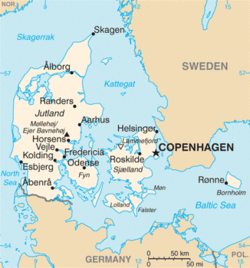Skagen
|
Skagen The Scaw |
|
|---|---|
 |
|
 Aerial view of the Skagen Odde peninsula in the far north of Jutland, from the southwest of Skagen |
|
 Location in Denmark |
|
| Coordinates: 57°43′N 10°35′E / 57.717°N 10.583°ECoordinates: 57°43′N 10°35′E / 57.717°N 10.583°E | |
| Country | Denmark |
| Region | North Denmark (Nordjylland) |
| Municipality | Frederikshavn |
| City status | 1413 |
| Government | |
| • Mayor | Birgit Hansen (Frederikshavn) |
| Population (2014-01-01) | |
| • Total | 8,198 |
| Time zone | CET (UTC+1) |
| • Summer (DST) | CEST (UTC+2) |
| Website | www.skagen.dk |
Skagen (IPA /ˈskæɡən/, Danish pronunciation: [ˈsɡ̊æːɪn]) is Denmark's northernmost town and the area surrounding it. Occasionally known in English as The Scaw, it is situated on the east coast of the Skagen Odde peninsula in the far north of Jutland, it is part of Frederikshavn Municipality in Region Nordjylland. It is located 41 kilometres (25 mi) north of Frederikshavn and 108 kilometres (67 mi) northeast of Aalborg. With its well-developed harbour, Skagen is Denmark's main fishing port and also has a thriving tourist industry, attracting some 2 million people annually.
Originally the name was applied to the peninsula but it now usually refers to the town itself. The settlement began in the Middle Ages as a fishing village, renowned for its herring industry. Thanks to its seascapes, fishermen and evening light, towards the end of the 19th century it became popular with a group of Impressionist artists now known as the Skagen Painters. In 1879, the Skagen Fisherman's Association was established with the purpose of facilitating the local fishing industry through the Skagensbanen railway, which opened as a narrow-gauged railway in 1890. The modern port of Skagen opened on 20 November 1907, and with the railway connections to Frederikshavn and the rest of Denmark, tourism began to develop.
In the early 1910s, Christian X and Queen Alexandrine often visited Skagen and brought friends from other European monarchies. They built the summer residence Klitgården, completed in 1914. Between the 1930s and 1950s the town grew rapidly, with the population more than doubling from 4,048 in 1930 to 9,009 in 1955. Skagen reached a peak population of 14,050 in 1980, after which it gradually declined. As of 1 January 2014 it has a population of 8,198. Thanks to the artistic community which still remains in Skagen, the local arts and crafts trade remains important to the income of the town with its numerous crafts shops and galleries. Chains such as the international jeweller Skagen Designs have branches in the town, and given the abundance of fresh fish coming in at the port of Skagen, seafood forms a staple in Skagen's restaurants.
...
Wikipedia
